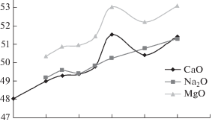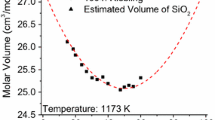Abstract
A method for calculating the temperature coefficient of the viscosity logarithm ∂logη/∂logT for oxide melts in the glass transition range has been proposed. The calculations are carried out using the additive formula, in which the composition is expressed in terms of coordination polyhedron content with allowance made for the formation of their hypothetical associates. The results of calculations are compared with the experimental data for ∼2200 compositions, which are represented in the SciGlass information system and contain 32 oxides all in all. The deviation between the results of calculations and the experimental data is comparable to the experimental error.
Similar content being viewed by others
References
Mazurin, O.V.,Steklovanie (Glass Transition), Leningrad: Nauka, 1986.
Nemilov, S.V., Viscous Flow of Glasses in Relation to Their Structure: Application of the Theory of Rate Processes,Fiz. Khim. Stekla, 1992, vol. 18, no. 1, pp. 3–44. [Sov. J. Glass Phys. Chem. (Engl. transi.), 1992, vol. 18, no. l,pp. 1–21].
Nemilov, S.V., Viscosity of Borate Glass-forming Melts: Specific Features of the BO4 Tetrahedron as a Kinetic Unit,Fiz. Khim. Stekla, 1997, vol. 23, no. 1, pp. 3–42. [Glass Phys. Chem. (Engl. transi.), 1997, vol. 23, no. 1, pp. 1–26].
Nemilov, S.V., On the Interrelation between Activation Entropy for Viscous Flow, Heat Capacity, and Valence Structure of Glass,Zh. Prikl. Khim. (Leningrad), 1964, vol. 37, no. 2, pp. 293–300.
Nemilov, S.V., The Viscosity and Structure of Glasses,Stekloobraznoe sostoyanie (Trudy IV Vsesoyuznogo soveshchaniya) [Vitreous State (Proc. IV All-Union Conf.)], Moscow: Akad. Nauk SSSR, 1965, pp. 64–68.
Nemilov, S.V., An Analysis of Activation Energy Parameters and the Nature of Viscous Flow of Inorganic Glasses,Uspekhi reologii polimerov vances in the Rheology of Polymers) Vinogradov, G.V., Ed., Moscow: Khimiya, 1970, pp. 241–252.
Gardon, R. and Narayanaswamy, O.S., Stress and Volume Relaxation in the Annealing of Flat Glass,J. Am. Ceram. Soc., 1970, vol. 53, no. 7, pp. 380–385.
SciGlass (Glass Property Information System), Version 3.5, Lexington: SciVision, 1998.
Pospelov, B.A., The Viscosity of Some Glasses in the Softening and Annealing Temperature Range,Zh. Fiz. Khim., 1954, vol. 28, no. 12, pp. 2178–2184.
Ota, R., Tsuchiya, F., Kawamura, K., Nakanishi, Sh., and Fukunaga, J., High and Medium Range Viscometers and Their Test with Some Alkali Silicate Glasses.,J. Ceram. Soc. Jpn., 1991, vol. 99, no. 2, pp. 168–172.
Lee Sang-Ki, Tatsumisago, M., and Minami, T., Transformation Range Viscosity and Thermal Properties of Sodium Silicate Glasses,J. Ceram. Soc. Jpn., 1993, vol. 101, no. 9, pp. 1018–1020.
Jenckel, E. and Schwittmann, A., Transformations punktbestimmungen an zusammengeseltzen Gläsern durch Messung der Viscosität,Glastech. Ber., 1938, vol. 16, no. 5, pp. 163–170.
Pospelov, B.A. and Evstrop’ev, K.S., The Viscosity of Glasses in Na2Si2O5-PbSiO3 System in the Softening Temperature Range,Zh. Fiz. Khim., 1941, vol. 15, no. 1, pp. 125–133.
Fulcher, G., Analysis of Recent Measurements of the Viscosity of Glasses,J. Am. Ceram. Soc., 1925, no. 8, pp. 339-355.
Priven, A.I., A New Equation for Describing the Temperature Dependence of the Viscosity of Glass-forming Melts,Fiz. Khim. Stekla, 1999, vol. 25, no. 6, pp. 647–659. [Glass Phys. Chem. (Engl. transi.), 1999, vol. 25, no. 6, pp. 491–497].
Liska, M., Klyuev, V.P., Antalik, J., and Stubna, I., Viscosity of Na2O · 2(TiO2, SiO2) Glasses,Phys. Chem. Glasses, 1997, vol. 38, no. 1, pp. 6–10.
Stolyar, S.V., Klyuev, V.P. and Bulaeva, A.V., The Viscosity and Thermal Expansion of Sodium Borosilicate Melts and Glasses in the Glass Transition Range,Fiz. Khim. Stekla, 1988, vol. 14, no. 6, pp. 914–917.
Nemilov, S.V., A Viscosimetric Study of the Structure of B2O3-Na2O Glasses,Izv. Akad. Nauk SSSR, Neorg. Mater., 1966, vol. 2, no. 2, pp. 349–356.
Nemilov, S.V. and Romanova, N.V., A Study of the Viscosity of Glasses in the PbO-B2O3 System in the Softening and Annealing Temperature Range,Izv. Akad. Nauk SSSR, Neorg. Mater., 1969, vol. 5, no. 7, pp. 1247–1251.
Gallup, J. and Dingwall, A.G.F., Properties of Low-Temperature Solder Glass,.Am. Ceram. Soc. Bull., 1957, vol. 36, no. 2, pp. 47–51.
Klyuev, V.P. and Bulaeva, A.V., The Viscosity and Thermal Expansion of Lead Borate Glasses in the Glass Transition Range,Fiz. Khim. Stekla, 1980, vol. 6, no. 6, pp. 674–678.
Komarova, N.V., Nemilov, S.V., and Davydenko, L.S., The Viscosity of Lead Borate Glasses at a High Content of PbO,Fiz. Khim. Stekla, 1987, vol. 13, no. 4, pp. 588–593.
Stolyar, S.V., Klyuev, V.P., and Bulaeva, A.V., The Viscosity and Thermal Expansion of Sodium Borate Glasses in the Glass Transition Range,Fiz. Khim. Stekla, 1984, vol. 10, no. 4, pp. 447–454.
Visser, ThJ.M. and Stevels, J.M., Influence of Water on Rheological Properties of Alkali Borate Glasses,J. NonCryst. Solids, 1972, vol. 7, no. 4, pp. 401–409.
Priven, A.I., Calculation of the Viscosity of Glass-forming Melts: IV. A Unified Method for Calculating the Viscosity of Silicate and Aluminate Melts,Fiz. Khim. Stekla, 1998, vol. 24, no. 1, pp. 48–62. [Glass Phys. Chem. (Engl. transi.), 1998, vol. 24, no. 1, pp. 31–40].
Priven, A.I., Evaluation of the Fraction of FourfoldCoordinated Boron in Oxide Glasses from Their Composition,Fiz. Khim. Stekla, 2000, vol. 26, no. 5, pp. 631–652. [Glass Phys. Chem. (Engl. transi.), 2000, vol. 26, no. 5, pp. 441–454].
Nemilov, S.V., Burunova, O.N., and Gilev, I.S., The Viscosity and Elasticity of Glasses in the Bi2O3-B2O3 System,Zh. Prikl. Khim. (Leningrad), 1972, vol. 45, no. 6, pp. 1193–1198.
Gattef, E.M., Dimitrov, V.V., Dimitriev, Y.B., and Wright, A.C., A Structural Study of Bi2O-B2O3 Glasses,Borate Glasses, Crystals and Melts, Wright, A.C., Feller, S.A., and Hannon, A.C., Eds., Sheffield: Soc. Glass Technol., 1997, pp. 112–119.
Shelby, J.E., Properties and Structure of B2O3-GeO2 Glasses,J. Appl. Phys., 1974, vol. 45, no. 12, pp. 5272–5277.
Nemilov, S.V. and Komarova, N.V., The Viscosity, Elastic Properties, and Structure of Glasses in the GeO2-B2O3 and GeO2-B2O3-La2O3 Systems,Fiz. Khim. Stekla, 1976, vol. 2, no. 3, pp. 262–267.
Mazurin, O.V., Streitsina, M.V., and Shvaiko-Shvaik-ovskaya, T.P.,Handbook of Glass Data: Part A. Silica Glass and Binary Silicate Glasses: Physical Science Data 75, Amsterdam: Elsevier, 1983.
Dell, W.J., Bray, P.J., and Xiao, S.Z.,11B NMR Studies and Structural Modeling of Na2O-B2O3-SiO2 Glasses of High Alkali Content,J. Non-Cryst. Solids, 1983, vol. 58, no. l,pp. 1–16.
Zhdanov, S.P., On the Possibility of Calculating the Tetrahedral Boron Content in Sodium Borosilicate Glasses from Their Composition,Dokl. Akad. Nauk SSSR, 1974, vol. 217, no. 3, pp. 581–584.
Wang, S. and Stebbins, J.F., On the Structure of Borosilicate Glasses: A Triple-Quantum Magic-Angle Spinning17O Nuclear Magnetic Resonance Study,J. Non-Cryst. Solids, 1998, vol. 231, no. 3, pp. 286–290.
Galoyan, K.K. and Knyazyan, N.B., Some Properties of Calcium Boroaluminate Glasses,Arm. Khim. Zh., 1989, vol. 42, no. 9, pp. 563–567.
Kostanyan, K.A. and Kirakosyan, S.Sh., The Viscosity of Calcium Boroaluminate Glasses over Wide Temperature Range,Arm. Khim. Zh., 1973, vol. 26, no. 7, pp. 555–562.
Nemilov, S.V. and Komarova, N.V., The Influence of Supercritical Fluctuations and Phase Separation on the Viscosity of Melts and Glasses in the PbO-Al2O3-B2O3 System,Fiz. Khim. Stekla, 1977, vol. 3, no. 6, pp. 568–575.
Nemilov, S.V. and Komarova, N.V., The Viscosity and Elastic Properties of Glasses in the BaO-B2O3-Al2O3 and CdO-B2O3-Al2O3 Systems,Fiz. Khim. Stekla, 1992, vol. 18, no. 6, pp. 77–87. [Sov. J. Glass Phys. Chem. (Engl. transl.), 1992, vol. 18, no. 6, pp. 446-451].
Keishs, Yu.Ya., Chekhovskii, V.G., and Pauksh, P.G., Structure of Glasses in the CaO-Al2O3-B2O3 System Studied by Vibrational Spectroscopy,Fiz. Khim. Stekla, 1987, vol. 13, no. 1, pp. 22–28.
Chekhovskii, V.G., Keishs, Yu.Ya., Petrov, Yu.A., Yurkova, S.N. and Pauksh, P.G., Change in the Fraction of Fourfold-Coordinated Boron Atoms Depending on Composition of Glasses in the MO-A12O3-B2O3 (M = Sr, Ba) Systems Studied by IR Spectroscopy,Fiz. Khim. Stekla, 1988, vol. 14, no. 1, pp. 150–153.
Chekhovskii, V.G., Kolobkova, E.V., Keishs, Yu.Ya., and Fokin, A.V., Structure and Properties of Aluminoborate Glasses Studied by Raman Spectroscopy,Fiz. Khim. Stekla, 1992, vol. 18, no. 2, pp. 146–153. [Sov. J. Glass Phys. Chem. (Engl. transi.), 1992, vol. 18, no. 2, pp. 174-177].
Nemilov, S.V. and Shmatok, L.K., A Study of the Viscosity and Structure of Glasses in the ZnO-La2O3-B2O3,Izv. Akad. Nauk SSSR, Neorg. Mater, 1968, vol. 4, no. 12, pp. 2166–2170.
Romanova, N.V. and Nemilov, S.V., A Study of the Viscosity in the Softening Range of Glasses in the BaOB2O3, BaO-B2O3-La2O3 and CdO-B2O3-La2O3 Systems,Izv. Akad. Nauk SSSR, Neorg. Mater., 1970, vol. 6, no. 7, pp. 1322–1326.
Chakraborty, I.N., Day, D.E., Lapp, J.C. and Shelby, J.E., Structure-Property Relations in Lanthanide Borate Glasses,J. Am. Ceram. Soc., 1985, vol. 68, no. 7, pp. 368–371.
Gray, P.E. and Klein, L.C., Viscous Flow of Sodium Phosphate Glasses from 101 to 1014 Poise,Phys. Chem. Glasses, 1986, vol. 27, no. 6, pp. 241–244.
Klein, L.C. and Gray, P.E., Water and the Modifier-toFormer Ratio in Sodium Ultraphosphate Glasses,Riv. Stn. Sper. Vetro (Murano, Italy), 1984, vol. 14, no. 5, pp. 29–32.
Gutzow, I., Streitsina, M.V. and Popov, E., Über den Temperaturverlauf der Viscosität des Graham-Glases und die Löslichkeit von Platin in NaPO3-Schmelze,Commun. Dep. Chem. (Bulg. Acad. Sci.), 1968, vol. 1, no. 2, pp. 19–28.
Kawazoe, H., Hasegawa, M. and Kanazawa, T., Effect of Cooling Rate on Vitrification of Condensed Sodium Phosphate Melts,J. Ceram. Soc. Jpn., 1972, vol. 80, no. 6, pp. 251–257.
Priven, A.I., Calculation of the Viscosity of Glass-forming Melts: III. The Alk2O-RO-Al2O3-SiO2 System,Fiz. Khim. Stekla, 1998, vol. 24, no. 1, pp. 31–47. [Glass Phys. Chem. (Engl. transi.), 1998, vol. 24, no. 1, pp. 19–30.
Karapetyan, G.O., Livshits, V.Ya., Nemilov, S.V., and Tennison, D.G., The Energetic Properties of MixedAlkali Aluminosilicate Glasses from the Data of Viscosity and Ultrasound Velocity Measurements,Fiz. Khim. Stekla, 1984, vol. 10, no. 5, pp. 567–574.
Hoffman, L.C., Kupinski, T.A., Thakur, R.L., and Weyl, W.A., The Low-Temperature Viscosity of Glass,J. Soc. Glass Technol., 1952, vol. 36, no. 171, pp. 196–216.
Taylor, T.D. and Rindone, G.E., Properties of Soda Aluminosilicate Glasses: V. Low-Temperature Viscosities,J. Am. Ceram. Soc., 1970, vol. 53, no. 12, pp. 692–695.
Pavlova, G.A., Leko, V.K., Gusakova, N.K., and Komarova, L.A., The Viscosity and Crystallization of Titanium Silicate Glass, inFiziko-khimicheskie issledovaniya struktury i svoistv kvartsevogo stekla (Physicochemical Investigations of Structure and Properties of Silica Glass), Moscow, 1974, no. 1, pp. 116–119.
Appen, A.A.,Khimiya stekla (The Chemistry of Glass), Leningrad: Khimiya, 1970.
Priven, A.I., Comparative Characterization of Methods for Calculating the Viscosity of Silicate Glass-forming Melts,Fiz. Khim. Stekla, 1997, vol. 23, no. 5, pp. 477–490. [Glass Phys. Chem. (Engl. transi.), 1997, vol. 23, no. 5, pp. 333–343].
Pospelov, B.A., The Viscosity of Some Glasses in the Softening and Annealing Temperature Range,Zh. Fiz. Khim., 1955, vol. 29, no. 1, pp. 70–75.
Author information
Authors and Affiliations
Rights and permissions
About this article
Cite this article
Priven, A.I. Calculation of the temperature coefficient of viscosity logarithm ∂logη/∂logt for oxide melts in the glass transition range from their composition. Glass Phys Chem 26, 455–469 (2000). https://doi.org/10.1007/BF02732066
Received:
Issue Date:
DOI: https://doi.org/10.1007/BF02732066




